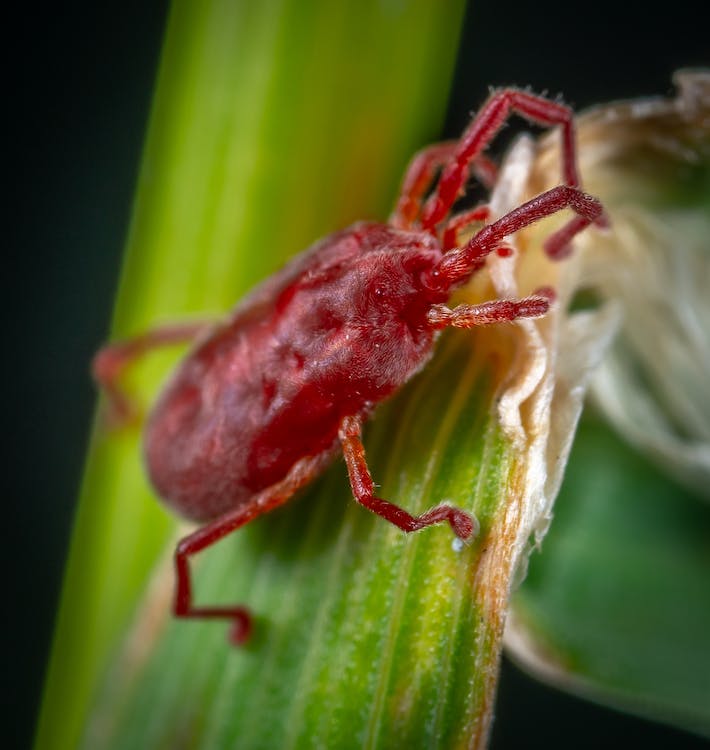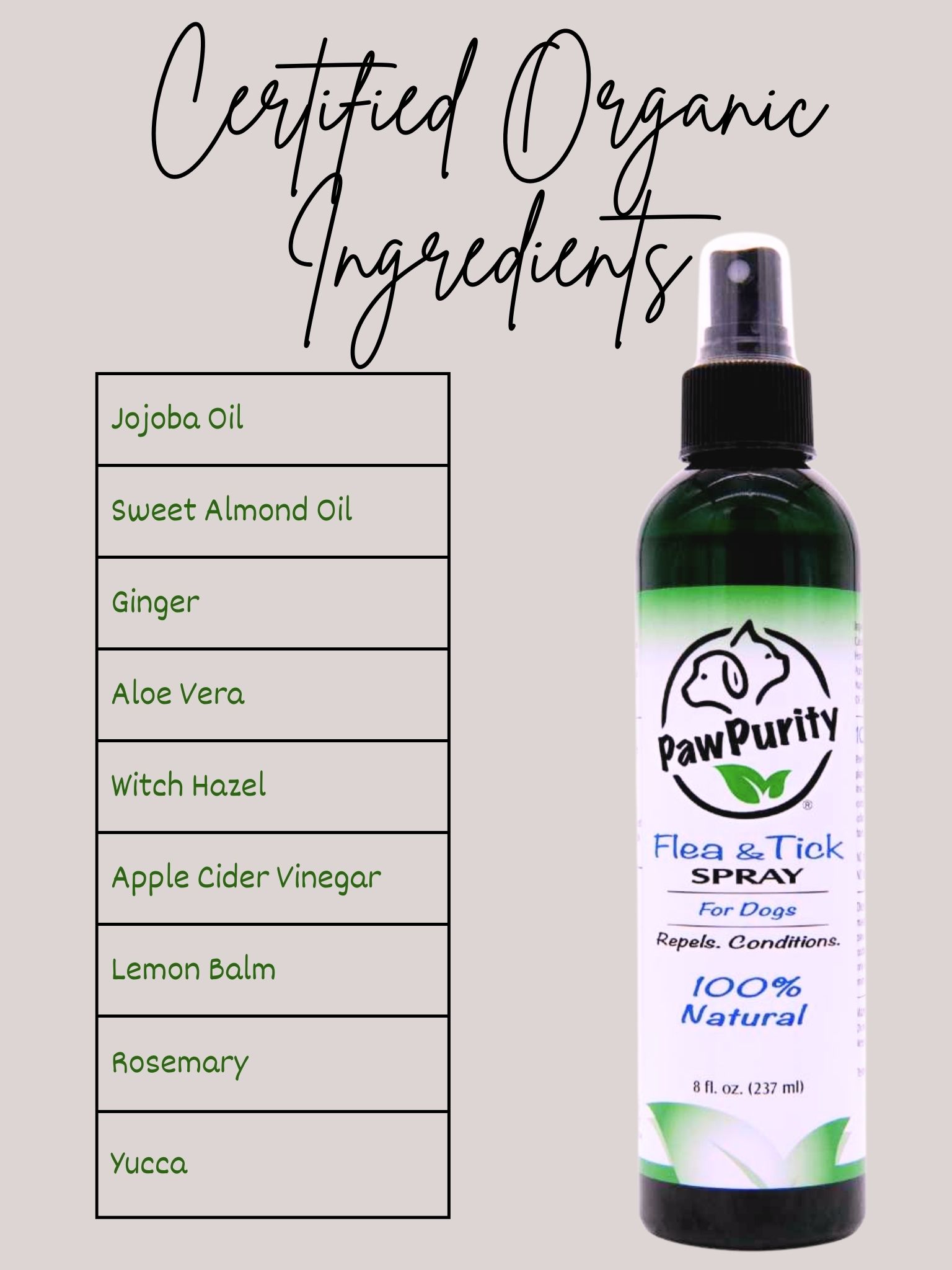Skin mite dermatitis in cats is a common condition that can be caused by skin mite bites. Skin mite dermatitis in cats, also known as scabies, is caused by an infestation of microscopic parasites called skin mites. It is characterized by intense itching, hair loss, and red, scaly skin. If left untreated, skin mite dermatitis can cause significant discomfort for cats and even lead to secondary infections. In this blog post, we’ll discuss the causes, symptoms, and treatment of skin mite dermatitis in cats and some preventative measures to help keep your cat safe from skin mites.
What are skin mites?
Skin mites on cats are tiny parasites that are highly transmittable. So even cats with no signs of skin mite dermatitis may be carriers. Treatment for skin mite dermatitis in cats usually consists of topical medications such as medicated or natural shampoos and sprays, oral medications, and changes in diet and environment to reduce the chances of recurrence. PawPurity’s Flea & Tick Spray has proven successful for this even though it was originally formulated for dogs.
Causes of Skin Mite Dermatitis in Cats
These tiny mites feed on the oils and proteins found in their hosts’ skin and can cause an itchy, red rash. In cats, skin mite dermatitis is typically caused by either Cheyletiella or Otodectes cynotis mites.
Cheyletiella mites live in the outer layer of the skin and can cause an intensely itchy rash. The rash appears as small, red bumps that may ooze a thick, yellow-white fluid. Otodectes cynotis mites live in the ear canal and cause severe itching, redness, and crusting around the ears. Both mites can be spread from animal to animal, so cats need to be kept away from other pets with skin mite dermatitis. These parasites are found in environments with low ventilation and improper or insufficient hygiene; thus, overcrowding, infrequent cleaning, and a damp climate are often contributing factors.
In addition to these environmental stressors, underlying allergies may create favorable conditions for these skin mites. Once infected, cats typically exhibit symptoms such as fur loss, scaly patches on the skin, redness, and itchiness that can become severe if not treated promptly.
How Do Cats Get Mites?
Cats can acquire skin mites from their environment or contact other animals. For example, fleas, ticks, and other external parasites can carry mites and spread them between animals. In addition, cats also can contract skin mites by sharing grooming supplies, bedding, or other items that harbor the parasites.
Once a cat has acquired skin mites, it is important to act quickly. If left untreated, skin mite dermatitis in cats often leads to more serious health problems such as infection, secondary bacterial infections, and even anemia. This is why seeking prompt medical attention and implementing an effective skin mite treatment for cats is important.
Symptoms of Skin Mite Dermatitis in Cats
The most common signs of this condition include:
- excessive scratching
- biting and licking of the affected area
- hair loss
- redness
- inflammation
- crusty or scaly skin
- small pimple-like bumps on the skin
In addition, cats with skin mite dermatitis may develop an unpleasant odor from the oils produced by the mites. This parasitic attack on a cat is highly uncomfortable.
Diagnosis of Skin Mite Dermatitis
Diagnosing skin mite dermatitis in cats may be challenging due to the wide range of symptoms and signs that can be present. To make an accurate diagnosis, a veterinarian will first take skin scrapings. Blood tests may be taken to help determine the presence of mites.
If skin mites are detected, the veterinarian will discuss the best treatment plan for the cat. Treatment options may include oral medications, topical ointments, natural repellent shampoos, or injectable medications. Depending on the severity of the infestation, more than one type of medication may be prescribed.
Owners need to keep in mind that skin mite dermatitis in cats can take some time to treat and eliminate. Even after all the mites are gone, some cats may experience skin irritations and itching. In these cases, the cat may require a more frequent bathing schedule using an organic repellent shampoo that is gentle on the skin, but effective enough to keep parasites at bay.
Treatments for Skin Mite Dermatitis
Treating skin mite dermatitis in cats typically involves a combination of medical and environmental management. It is important to reduce the exposure of the cat to mites and prevent further infestation.
1. Medical Treatments
Medical treatment usually involves a prescription topical or oral medication that kills mites. Topical medications are usually applied to the affected area of the skin, like organic flea and tick shampoos, while oral medications are usually given as tablets or capsules. Depending on the severity of the infestation, your veterinarian may also recommend treating all cats in the household with appropriate anti-parasite medication and/or flea and tick-repellent shampoo to prevent re-infestation.
2. Environmental Management
In addition to medical treatments, reducing exposure to mites is also important for successful treatment. This includes frequent vacuuming and cleaning pet bedding, furniture, and carpets; washing and disinfecting cages and litter boxes; and frequently misting the cat with dust mite deterrent sprays.
3. Diet and Hygiene
It is also important to keep up good hygiene practices, including regular brushing and combing to remove debris from their fur and skin. Additionally, providing healthy nutrition and plenty of access to clean water can help boost cats’ immune systems, which can help fight off mites.
By combining environmental management and regular bathing with repelling shampoos, skin mite dermatitis in cats can be avoided. However, if you think your cat may already have skin mite dermatitis, consult your veterinarian to discuss treatment options.
Can You Get Skin Mites from Cats?
The answer is yes; you can get skin mites from cats. Skin mites are easily transferred to humans and can cause skin irritation.
However, skin mites are not transferable between humans; however, it is still possible for the mites to be transferred from cats to humans. To reduce the risk of transfer, wash hands after handling an infected animal and wear protective clothing when encountering pets. Additionally, ensure that all areas of the home are cleaned thoroughly and regularly to limit the spread of skin mites.
How to Prevent Skin Mites in Cats?
One of the best ways to prevent skin mite dermatitis in cats is bathing it at least once a month with a repelling shampoo.
Brushing cats regularly helps to keep the fur clean and free from parasites.
Look for signs of irritation or itching, which is a possible mite infestation.
In addition to regular grooming and monitoring, keep cats’ environments as clean and free from allergens as possible. Allergens such as dust and pollen can aggravate an existing case of skin mite dermatitis, so keep the home environment needs to be free from these agitators.
Keep cats away from other animals, especially those with fleas or other parasites. Following these simple tips can help keep cats safe from skin mite dermatitis and ensure they stay healthy and happy.
Final Words
In conclusion, skin mite dermatitis in cats is a common condition that can be caused by various environmental factors and can lead to severe irritation and discomfort. Knowing the symptoms and cause of skin mite dermatitis can help identify the problem and take the necessary treatment steps. With the right approach, skin mite dermatitis easily can be managed with lifestyle changes. At times, professional veterinary services may be necessary.
Flea & Tick Knowledge
Flea & Tick Protection
Safe Flea Shampoo For Kittens
by Lisa Porter
on Oct 24 2022
Fleas are a common problem for both cats and dogs. Kittens, in particular, can be super susceptible to flea infestations as they have not yet built up the immunity that older cats have. Flea shampoos are one way to deal with a flea infestation by killing and repelling them. However, it is essential to use a safe shampoo that will not harm your furbaby and these are hard to find. This blog post will discuss the best flea shampoos for kittens and how to use them safely.
Flea & Tick Protection, Uncategorized
Tick Protection
by Lisa Porter
on Jul 07 2023
Tick protection is essential during warmer temperatures. Tick bites can be dangerous to dogs and cats due to the potential transmission of diseases. They can carry and transmit dangerous pathogens such as Lyme disease, ehrlichiosis, anaplasmosis, and babesiosis. These diseases can cause a range of symptoms, including fever, lethargy, joint pain, loss of appetite, and more severe complications if left untreated. Protecting your pets from tick bites is crucial to their overall health and well-being. This means using everything in your tool box to keep the little buggers from latching onto your furbaby. Natural tick shampoos and sprays, lyme disease vaccinations and good housekeeping are essential. Here are some ideas you can follow to for ultimate tick protection.
Flea & Tick Protection
What Flea Spray is Safe for Pets
by Lisa Porter
on Oct 10 2022
Fleas, those pesky little bloodsuckers, can make your pet’s life miserable, and they are the bane of many an owner’s existence. Luckily, there are several safe flea spray products that help fight these unwanted guests before they become a problem that needs to be dealt with by chemicals or even more drastic measures like flea collars or dips.





















